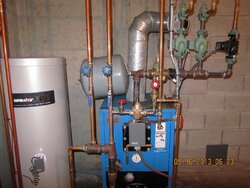I am in the process of of having a pellet boiler installed but will be leaving my existing oil boiler in place.
The oil boiler is leaking water though.
I have water leaking from the pressure relief valve at a pretty steady pace. It fills up a large mop bucket in about 2-3 days time.
The expansion tank on the oil boiler was mounted sideways rather than vertically. It is unsupported and is sagging. However when the near side of the tank (what would be top if mounted vertically) is hot while the far side (what would be bottom if mounted vertically) is cool and it does sound like there is air in the tank when performing the knock test. This seems to indicate a working expansion tank. Does this mean that the expansion tank is not likely the cause of the PRV leaking?
Another symptom is that the system always seems to have zero pressure according to the boiler pressure guage. I believe the pressure guage is working because if I hold the pressure valve open I can see the pressure increasing on the guage.
Any ideas on what might be causing the leaking and zero pressure?
Thanks guys
The oil boiler is leaking water though.
I have water leaking from the pressure relief valve at a pretty steady pace. It fills up a large mop bucket in about 2-3 days time.
The expansion tank on the oil boiler was mounted sideways rather than vertically. It is unsupported and is sagging. However when the near side of the tank (what would be top if mounted vertically) is hot while the far side (what would be bottom if mounted vertically) is cool and it does sound like there is air in the tank when performing the knock test. This seems to indicate a working expansion tank. Does this mean that the expansion tank is not likely the cause of the PRV leaking?
Another symptom is that the system always seems to have zero pressure according to the boiler pressure guage. I believe the pressure guage is working because if I hold the pressure valve open I can see the pressure increasing on the guage.
Any ideas on what might be causing the leaking and zero pressure?
Thanks guys


